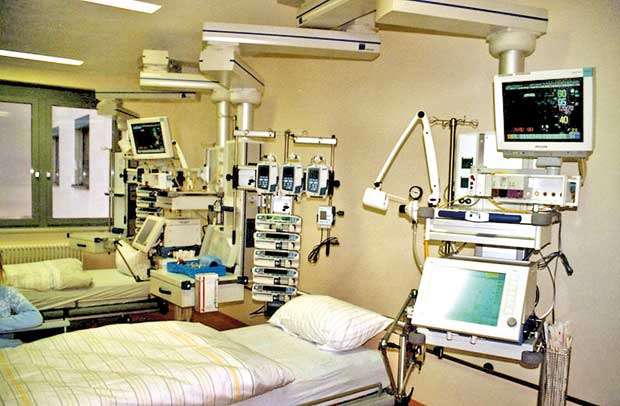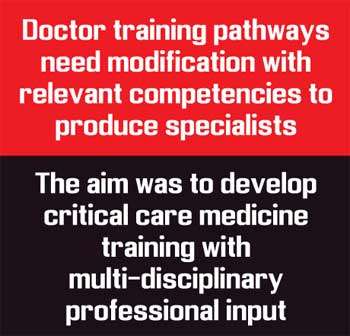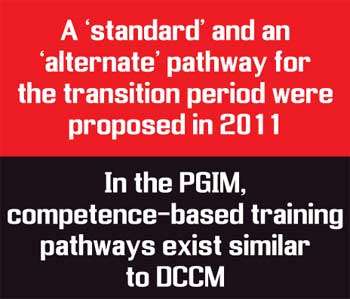Reply To:
Name - Reply Comment
Last Updated : 2024-04-25 00:00:00

Medical specialities evolve for the benefit of patients. It resolves the demand and enhances clinical effectiveness.We are duty bound to support this evolution and create specialist services to serve the need.Quality healthcare is based on this concept and it is patient-centred, not provider centric. Accordingly, doctor training pathways need modification with relevant competencies to produce specialists with matching new skills.Such doctors are traditionally board certified as specialists via an ‘exit’ examination (MD) to achieve a minimum national standard or benchmark. Today, board certification of critical care specialists in Sri Lanka has no ‘exit’ examination, but is primarily testimonials based. This needs urgent redress. 
The impetus for the formation of a specialty board for critical care medicine in 2008 under the Board of Study for Multi-Disciplinary Study Courses of the Post Graduate Institute of Medicine (PGIM) was the plight of junior medical officers serving in intensive care units. The aim was to develop critical care medicine training with multi-disciplinary professional input. After much thought and discussion, a diploma critical care medicine curriculum (DCCM) was installed in 2009 based on the CoBaTrICE model (An International Competency Based Training programme in Intensive Care Medicine for Europe and other world regions) as a stepping stone for a higher degree in Critical Care i.e. MD. The DCCM training programme was of high intensity (60 credits) and matched level 10 of Sri Lanka Quality Framework (SLQF). A world renowned critical care specialist was present as an examiner.
A ‘standard’ and an ‘alternate’ pathway for the transition period were proposed in 2011. This ‘alternate’ pathway allowed anaesthetists practising critical care medicine to continue to do so and enter a trainee tailored training programme until the country produced a sufficient number of MD qualified critical care specialists via the ‘standard’ pathway. This model was approved by the Senate of the University of Colombo. The purpose was to create an independent ‘standard’ training programme for Critical Care Medicine and phase out the ‘alternate’ pathway by 2016.
In 2011, the College of Anesthesiologists took over the reins of this training programme virtually by force and the Board of Study in Anaesthesiology (BOS-A) saw its responsibilities being sanctioned for 1 year by the PGIM in the first instance. But they continued regardless. Sadly, for the past 8 years, no action has been taken to promote the ‘standard pathway’ of training. The above diplomats were neither given an opportunity to take up appropriate leadership roles to shape up critical care services in Sri Lanka nor was a window opened for them for further training for MD. As a direct consequence, many of the diplomats migrated and became consultant critical care specialists elsewhere. The exodus was inevitable. The PGIM failed in its duties to the trainees and public alike.
 Scrapping of diploma programme
Scrapping of diploma programmeInstead of promoting this training program, the College of Anaesthetists decided to do away with the diploma programme by demoting its value and removed its foreign examiner. It decided to hold onto the ‘alternate’ pathway of training as the final destination to critical care specialisation. Repeated requests by the Ministry of Health to install the ‘standard’ training pathway fell on deaf ears. The Ministry of Health, the biggest employer of doctors in Sri Lanka, desperately wanted the above diplomats with intermediate training in Critical Care to maintain a credible intensive care service in its hospitals.
The lack of recognition of the problem and the inability to rectify the issues raised make the current specialty board in critical care medicine, hosted within the BOS-A, not fit for its purpose. If no action is taken, the DCCM would have no trainee applicants and specialty development of Critical Care Medicine in Sri Lanka will see a natural demise. In order to conceal this diverse interest, dual board certification in critical care medicine was offered to anesthetists. This self-served privilege was proposed, scrutinised and approved by the same board of study (BOS-A) constituted of only anesthetists. No ‘exit’ examination on critical care medicine was necessary.
In the PGIM, competence-based training pathways exist similar to DCCM. Ironically, anesthesia is one of them. In its training, the BOS-Ahas hosted a Part 1 A (a clinical practice-based examination) at the end of the 1st year of training followed by a Part 1 B, a theory test and the final Part 2 MD as its exit examination for decades. Thus,BOS-Ais fully aware of the need of basic clinical competence training for the junior members practicing anesthesia, but denies the same for critical care. Modern critical care is not a speciality that can be remotely managed from home or whilst engaged in another job in the operating theatre. The patient outcomes in critical care heavily depends on the presence of highly trained doctors and nurses on-site (24/7) and capable of recognising and rectifying deteriorating trends and mishaps long before irreversible damage is done.

Both critical care medicine and emergency medicine were recommended to be accepted as separate specialities in Sri Lanka by the then Minister of Health, the current President Maithripala Sirisena in 2011 following a review of its timely need. The University of Colombo hosts the only Institute of Post Graduate medical training in this country. Therefore, as a public funded organisation, the PGIM is obliged to shape up its training programs to serve the evolving needs of the Ministry of Health that serves all citizens of Sri Lanka.
Every clinical specialty encounters disease conditions that would need intensive care. Therefore, every clinician has a right to participate in the care of their patients, in a critically ill state, to resolve therapies of the original illness. A majority of patients needing critical care services have coexisting medical and surgical problems. Thus, multi-disciplinary inputs are essential to direct training until critical care specialists are produced.
Medicine evolves with time. When Hippocrates initiated medicine as a profession, there were no specialities. Specialities evolved to enhance care for patients and improve outcomes. Thus, the sole purpose of generation of specialities is natural, initially born as a sub-specialty of a parent specialty and then raised to become independent with time with greater experience in its development. For example, there were no paediatricians in 1970’s, but they evolved from adult physicians. In 1990s it was clear that paediatricians could not offer the best services for neonates and hence neonatologists emerged. Although paediatricians were nurtured initially by the College of Physicians, they claim no ownership of paediatrics as a sub-specialty. A similar pathway of development will have to be followed for critical care medicine.
The evolution of critical care medicine in the world began with the concentration of essential equipment and staff in one place of the hospital to serve the most sick patients; a concept first initiated by Florence Nightingale in 1850’s. In 1950’s with a polio epidemic in Denmark, mechanical ventilation was instituted and quite rightly anesthetists had a major role to play. However, with evolution of medicine it became clear that critical care needs new skills to improve the outcome of patients.
The historical contribution by the College of Anaesthetists for the development of critical care medicine should be celebrated, as well as their continued involvement to produce trained future specialists in critical care. This is because some transferable skills of anaesthesia are needed for critical care specialist training. Critical Care specialists encompass other skills and competencies including the ability to lead a team of multi-professional doctors for the benefit of critically ill patients. Multi-organ failure resulting from dengue is one such example. Several recent media reports involving VIPs allude to the consequences of lack of team work.
The very fact that the Sri Lanka College of Anaesthesiologists denial of the need for multi-professional input to critical care medicine development is testimony to its intentions to delay its progress to become an independent specialty in this country, but why? It is also unfair that a junior doctor is expected to complete his training in anaesthetics as enforced by the BOS-A to be able to commence training in critical care. This is not dissimilar from demanding compulsory training to be a ‘cricketer’ before becoming eligible to be a trainee ‘rugby player’ just because cricketers’ training pathway had a transferable skill such as running.
 DCCM Examination
DCCM Examination It is also surprising that PGIM has allowed board certification of a ‘specialty’ for such a long time with no ‘exit’ examination in its training pathway. The only credible critical care specialty-based examination held by the PGIM to date is the DCCM which is more comprehensive and detailed than any contained in anaesthesia prospectuses. In fact, the diploma holders have undergone the exact duration of critical care medicine training to that of post MD anaesthesia trainees who have become eligible for board certification in critical care without a single ‘exit’ examination in critical care medicine.
Critical Care Medicine already has established sub-specialities in cardiac, neuro, paediatric, renal and liver care in developed countries, and is usually primary disease oriented, and maintains inputs from primary referring specialists. A critical care specialist predominantly focuses on establishing (resuscitation) and maintaining adequate vital organ function by means of pharmacological, physiological, or artificial manipulation or replacement therapy. The primary aim of such stabilisation and maintenance of vital functions is to borrow time in life for natural healing process to take place assisted by the specific therapies instituted by relevant specialists until sustainable organ function has returned naturally or via artificial support of organs or following transplantation.
In the UK, for example, intensive care medicine (ICM), now termed critical care medicine, achieved specialty status in 1999. In the early 1990’s the foundation of the Faculty of Intensive Care Medicine was by seven parent colleges. This new faculty wasn’t a destination, but was a starting point to establish Critical Care Medicine as a separate specialty. In 1992, the Royal Colleges in the UK formed the Joint Advisory Committee for Intensive Therapy and this became the Intercollegiate Board for Training in ICM in 1996. This was very similar to the establishment of a Specialty Board in Critical Care Medicine under the Board of Study for Multi-Disciplinary Study Courses in 2008 in Sri Lanka, but sadly moved away for sole management by BOS-A in 2011. This has effectively denounced the need for development of a multidisciplinary professional identity in critical care training in Sri Lanka.
In January 2011, the General Medical Council (GMC) required Faculty of ICM-UK to develop a primary specialty training programme for ICM, a fact that the Sri Lankan College of Anaesthesiologists ignore to be in existence. Instead, the Sri Lanka College of Anaesthesiologists renamed themselves to include intensive care in 2014 without committing to the essential pillars needed for critical care medicine development. In contrast to the GMC, the Sri Lanka Medical Council remains silent.
I hope wisdom will prevail in this ongoing saga. It’s our responsibility to ensure that a safe, effective, efficient, well-led service is delivered to the public through the maintenance of the highest standards of training. Specialty formation should be to achieve the above for patients and not to retain territorial boundaries for provider gain. Moving the Speciality Board for Critical Care Medicine to be hosted under the Board of Study for Multi-Disciplinary Study Courses shall mark a new beginning.

Add comment
Comments will be edited (grammar, spelling and slang) and authorized at the discretion of Daily Mirror online. The website also has the right not to publish selected comments.
Reply To:
Name - Reply Comment
US authorities are currently reviewing the manifest of every cargo aboard MV
On March 26, a couple arriving from Thailand was arrested with 88 live animal
According to villagers from Naula-Moragolla out of 105 families 80 can afford
Is the situation in Sri Lanka so grim that locals harbour hope that they coul